Any number of ailments might result in a dog’s hind-legs losing strength. The following hints will help your veterinarian identify the problem’s root cause.
Regardless of the source, a dog’s weakness normally manifests itself first in the hind limbs. This seems obvious given how much work the dog’s hind-legs perform. They are in charge of pushing the body upward from a seated or lying position as well as driving the body forward when moving. You will be made aware of a weakness-related issue if you experience difficulty with these routine daily tasks.
What does a weak set of back legs on your dog look like? Hind-limb weakness is indicated by a variety of behaviors, including slow rising, sinking on the back limbs, dragging the tops of the toes, swaying of the hind end, occasionally crossing of the limbs, intolerance to physical exertion, slipping, sliding, and collapse of the hind end. The ability to stand on its hind-legs may also suddenly disappear in your dog.
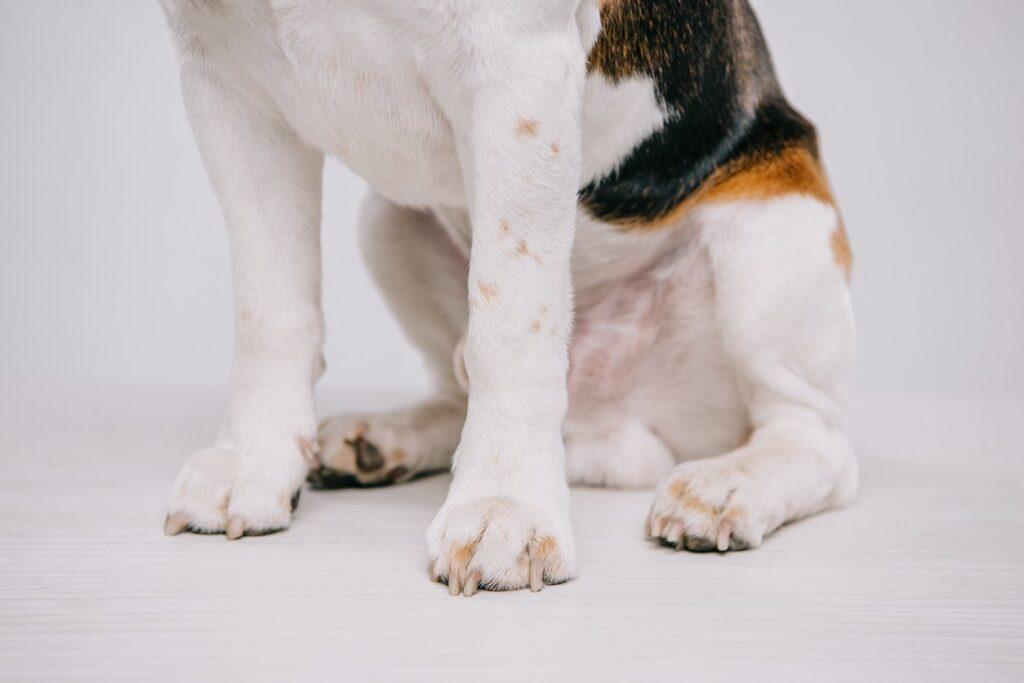
If your dog exhibits any of these symptoms, you should pay attention to a few details that can aid your vet in identifying the problem:
Some problems are more likely than others depending on your dog’s age and size. This is applied to the diagnostic procedure as well.
The four primary categories of causes of hind-leg weakness are orthopedic, neurologic, metabolic, and cardiac.
Chronic joint inflammation/pain is the primary orthopedic cause of canine hind-leg paralysis (osteoarthritis, degenerative joint disease). Although arthritis is obviously painful, it is frequently accompanied by compensatory pains, which are muscle aches and pains. The dog finds it difficult to stand up and move as a result. He might become more sedentary as a result, which would worsen the condition by causing him to lose muscle mass and fitness.
Due to the wear and tear on the joints over time, arthritis most frequently affects older dogs; overweight dogs endure an additional burden because of the increased tension those extra pounds place on the joints. Hip arthritis may appear in puppies of dogs with hip dysplasia, which results in improperly shaped hip joints. These arthritic disorders typically present with a delayed, sneaky onset of hind-leg weakening. It won’t appear to have occurred overnight.
Immune-mediated arthritis and Lyme arthritis are two acute types of arthritis that can cause a dog’s hind end to suddenly weaken. In addition to fractures and intervertebral disc disease (IVDD), overweight dogs frequently suffer from bilateral anterior cruciate ligament (ACL) tears, which are additional orthopedic reasons of hind-leg paralysis. Your veterinarian will be able to identify these diseases and recommend the proper treatment with the use of blood tests and x-rays.
IVDD: When an unhealthy disc (or discs) puts strain on the spinal cord and causes neurologic weakness, IVDD transitions from an orthopedic problem to a neurologic one. The majority of these instances are treatable medically, but surgery is necessary if paralysis develops or medical treatment is ineffective.
Spinal tumors: Similar symptoms are brought on by neurologic disorders such as spinal tumors. For a diagnosis, sophisticated imaging techniques like computed tomography (CT) or magnetic resonance imaging (MRI), as well as occasionally cerebrospinal fluid examination, are needed.
Diskospondylitis: An infection of the intervertebral disc and the ends of the surrounding vertebrae is known as diskospondylitis. It can be challenging to diagnose, produces hind-limb paralysis regularly, and is excruciatingly painful. Long-term antibiotic use is the course of treatment (six to 12 months). Your dog may need more x-rays and/or more sophisticated testing, such as CT or MRI, to make a certain diagnosis because this ailment can be challenging to diagnose in its early stages. These canines can fully recover if they are diagnosed and treated appropriately.
Lumbosacral stenosis: Cauda equina syndrome, or lumbrosacral stenosis, is a degenerative disorder that affects only the lumbosacral joint and is related to IVDD. This joint joins the last vertebra to the pelvic region. It differs from the other intervertebral joints in that the spinal cord sends all of the peripheral nerves that travel to the hind end to this joint. In addition to being extremely painful, this type of disease typically results in neurologic impairments and weak hind limbs.
Degenerative myelopathy: Weakness in the hind-legs is a symptom of degenerative myelopathy (DM), a slow but progressive deterioration of the spinal cord. Although it affects various breeds, the German Shepherd Dog serves as the disease’s mascot. Typically, older and middle-aged canines are affected. There is just supportive care available as a treatment for DM right now.
Myasthenia gravis: An autoimmune neuromuscular condition called myasthenia gravis (MG) causes muscle weakness that worsens with exertion. It may begin with weakness in the back limbs but quickly progresses to total body weakness and collapse.
Here’s a situation that is typical of Myasthenia gravis: Your dog wakes up after a nap and acts normally. As soon as you start walking, he begins to sink, slip, and stumble until he is unable to stand or walk. He can resume short-term function after a period of rest that enables the replacement of damaged neuromuscular transmitters. A blood test is required for diagnosis. Long-term therapy is required (six months or longer). Some canines will have remission and resume their regular lives. Others will require care and support throughout their lives.
Exercise-induced collapse: Labrador Retrievers and a few other breeds are susceptible to the genetic illness known as exercise-induced collapse (EIC). It usually manifests itself between the ages of 6 months and 2 years. It takes place following several minutes of intense exercise. The dog quickly starts to weaken and lose coordination in his hind limbs, eventually collapsing. For this, there is no cure. Avoiding vigorous exercise is one method of prevention. It is crucial that you get your puppy from a breeder who has tested the parents for this gene for the aforementioned reasons. Have your adoptive dog’s EIC gene checked if he exhibits these symptoms.
Idiopathic vestibular syndrome: In elderly dogs, idiopathic vestibular dysfunction is a frequent cause of weakness in the rear limbs and lack of coordination. It appears abruptly and may give you the impression that your dog is having a stroke. This disorder’s origin is uncertain. It typically comes with a head tilt and balance problems. With supportive care, the majority of dogs will recover in time.
Numerous illnesses transmitted by ticks can result in generalized neuromuscular weakness, which may first show in the rear limbs. If you notice ticks on your dog, let your vet know.
Hypoglycemia (low blood sugar), anemia (few red blood cells), and hypokalemia (low potassium) are a few examples of metabolic conditions that might weaken the hind-legs. Blood testing can quickly diagnose this. For these problems to be solved, identifying their underlying causes, which necessitates more diagnostic testing, is crucial.
Weakness can result from endocrine conditions such as insufficient thyroid hormone (hypothyroidism) and underactive adrenal glands (Addison’s disease). Blood tests are used to diagnose both conditions, and there is no cure.
Hepatic encephalopathy, a metabolic disorder that causes sporadic weakness and confusion and is most noticeable after eating, can be brought on by certain liver disorders.
All of the body’s tissues must receive sufficient blood flow and oxygen, which depends on healthy heart function. Weakness happens when heart function is compromised, regardless of the underlying cause. Again, for the reasons already mentioned, weakness in dogs typically manifests itself in the hind-legs first.
Heart illnesses that affect dogs include heartworm disease, congestive heart failure, heart muscle disease (cardiomyopathy), cardiac arrhythmias, cardiac or pericardial tumors, and fluid in the sac surrounding the heart (pericardial effusion).
Your veterinarian will discover a cardiac explanation for the hind-leg weakness you’ve noticed during your dog’s physical examination, and treatment and diagnosis will proceed from there.
As you can see, there are many different possible reasons why dogs’ hind limbs get weak. Because of this, it’s crucial to have your dog inspected if you notice this problem; never just brush it off as a “old dog” problem. Many of the underlying causes can be ruled out by your veterinarian, who can then hopefully provide a conclusive diagnosis. Even if your dog is quite old, diagnosing and treating some of these disorders can completely transform his life!
There is no cure for some chronic illnesses, such as osteoarthritis. However, there is a lot you can do to enhance and preserve your dog’s quality of life for a very, very long period. Your sensitive loving care and dedication to supportive measures are the first step.
Support for Mobility Issues Caused by Arthritis
If you are interested in more information about our Posh Dog Knee Brace you can contact us on our form or if you would like to purchase our brace you can click here, you can also join our Facebook Group page to hear how other dog parents help their dog with their pain management and therapies.
Age-related osteoarthritis affects many older dogs, as well as some larger breeds who are genetically predisposed to it. Dogs that have arthritis have changes in their affected joints, which can be excruciatingly unpleasant for your pet.
Though it can affect any joint, arthritis most frequently affects the shoulders, hips, elbows, and knees. In addition to localized damage, genetics, and disease, it can also be brought on by continual wear and tear.
If your dog exhibits any of the following 7 symptoms, schedule an appointment with your veterinarian to develop a care plan.
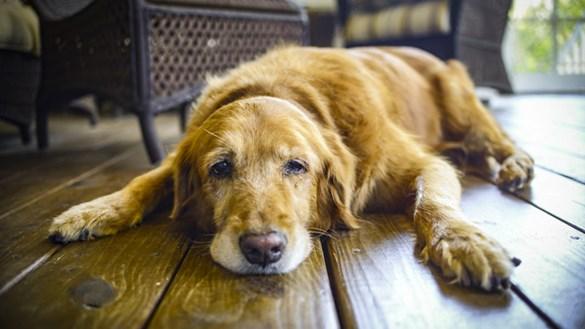
You could notice that your dog is hesitant to perform tasks that they previously completed without issue.
Maybe you’re pet used to dash into your car as soon as the doors opened, but now they seem unconcerned. You could observe that your dog has trouble ascending or descending the steps. Has your pet lost interest in playing and running around like it once did? Maybe you take walks slowly?
If your pet exhibits these changes, arthritis may be to blame. These formerly simple actions probably hurt now that your joints are inflamed.
You might notice your pet limping or favoring one or more legs over the others, depending on which joints are damaged. Your pet may even become lame in one or both rear legs if the spine is harmed.
Upon getting up or down, your dog could appear to be in discomfort or stiffness, but once they have walked a little and “warmed up,” it seems to go away.
Joint inflammation can make the affected parts feely to the touch.
If your dog appears to be rejecting your affection or howls in pain when you pet them, you may have found the source of the issue.
Has your once-adorable dog started acting more and more like an elderly man?
If moving caused you chronic discomfort, you probably would have a shorter fuse as well. That also applies to your dog. When you try to touch them, they could bite or snap, especially if you are handling them in a way that makes the discomfort worse.
Dogs with discomfort frequently don’t want to be bothered. Your pet might spend more time in the house’s quiet corners or quit pursuing you around. It’s possible that their schedule will change and they won’t be available for your usual walk or play session.
An arthritic pet will frequently focus their attention on hurting joints. They may frequently lick or chew on one or more locations, even to the point of causing hair loss and inflamed skin.
Pain wears them out!
Pets won’t want to walk as far or play as much if it is difficult for them to move around. They might spend more time relaxing or sleeping instead.
Dogs with arthritis frequently experience muscular atrophy from inactivity.
Some muscles will gradually atrophy as a result of less use. You might notice that one or more of your legs appear thinner than the others if you have arthritis in those legs.
Please schedule an appointment with your veterinarian as soon as you can if you see any of these symptoms in your pet. Even though arthritis cannot be cured, developing a treatment plan in its early stages can help your dog live a better life and make the condition more tolerable.
If you would like more information on your dog’s arthritis please contact us on our form, or you can visit our Facebook Group to see how others have helped their dogs. If you are interrested in purchasing a brace for your dog you can visit our shopping page.
Dog Knee Recovery Without Surgery
By Rosemary Levesque, Licensed Spiritual Healer
Second Nature Healing®https://secondnaturehealing.com
Rosemary@secondnaturehealing.com or call directly 503-747-3307
The following article is written in gratitude to Posh Dog Knee Brace for their support during Gracie’s recovery from a torn CCL. Gracie wore the brace and healed well without surgery. In honor of Gracie who had a long healthy life, I’m offering:
The cranial cruciate ligament (CCL) in dogs is a band of connective tissue that connects the upper leg bone (thigh) to the two lower leg bones (tibia and fibula) at the knee joint – called the stifle in dogs. The CCL helps stabilize the stifle, and is highly vulnerable to tears which destabilize the joint. Damage to the knee joint is the leading cause of rear-leg lameness and the major cause of degenerative joint disease in dogs. (1)
If you can’t wait to get started with healing and recovery, please begin here.
My number ONE product source for healing and recovery is https://avinihealth.com/rosemary.
These products are designed with humans in mind, but with my years of experience working with animals, I know how critical it is to use these products, safely and easily, across the board, with all species. Call me for a consultation on how to help your dog heal faster, without surgery, using the Posh Dog Knee brace and my products.
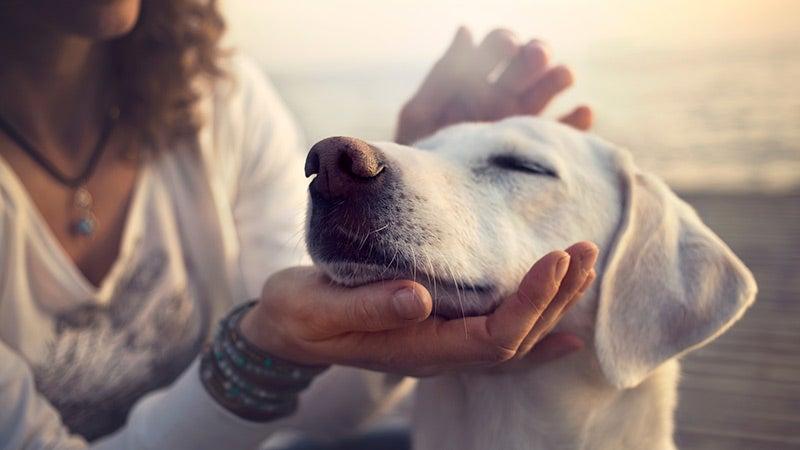
There are many situations that could result in a CCL tear:
Contributing factors like obesity, genetics, and general health may also have a role in causing a torn CCL. Since animals are excellent at hiding their injuries and illnesses, you’ll want to be especially observant if you suspect a tear. In addition to limping or lameness, watch for muscle atrophy in the thigh or imbalance in the spine.
When Gracie jumped into the car as usual one beautiful spring day after a pleasant walk in the park, she yelped in pain. Yet after her initial jolt, she seemed fine. She ate and walked normally for several weeks until we had our next vet visit, a yearly wellness check-up. Suddenly she picked up her hind leg, revealing her lameness. It surprised me that she’d wait until we were in his office to say something about her problem. She hadn’t shown me any sign of lameness since the incident a few weeks prior.
A veterinary examination for stifle injury usually includes manipulation of the joint and is called a “drawer test”. Physical manipulation of the joint forces the ligaments to stretch and tear more. Unfortunately, it was an issue and Gracie became obviously lame after that. That’s why I add this test to the list of causes. Even if a small tear already exists, it can worsen after such manipulation. If you suspect a torn CCL, do NOT allow your vet to perform the drawer test.
Our vet suggested that we see a specialist for CCL surgery. He also offered cold laser treatments at his clinic to help speed healing and recovery. I felt hopeful about Gracie’s healing and recovery with the healing methods I already know and use. So, in addition to frequent cold laser treatments, my plan included Reiki, essential oils, and acupuncture. I opted to not have invasive, expensive surgery.
The most common response to a torn CCL is to perform a surgery called Tibial Plateau Leveling Osteotomy (TPLO). In this surgery, the tibia, a lower leg bone, is cut (leveled) and rotated to change the direction of movement. A plate is added to secure the new location of the joint. Following weeks of immobility and pain management with medications the problem may be resolved. The cost of surgery and x-rays may range from $2500 to upwards of $6000.
However, cost isn’t the only issue to consider. Weeks of restrained immobility are not only depressing for your active animal, but difficult to control and have other effects such as weight gain, muscle atrophy, and risk of infection as well as the risks associated with the surgery itself. Pain medications can often have harmful side-effects. More importantly, studies now show a definite link between TPLO surgery and osteosarcoma (bone cancer) at the site of surgery.
“. . . dogs with a history of TPLO were 40 times as likely to develop proximal tibial osteosarcoma as were dogs with no history of TPLO. In addition, each 1-kg (2.2-lb) increase in body weight was associated with an 11% increase in the odds of proximal tibial osteosarcoma.” (2)
What’s really best for your dog? Is there another way?
Gracie did well with the holistic methods I used to support her healing. Most importantly, we were still able to walk her short distances while she gradually improved. We purchased a set of stairs for the car so she wouldn’t jump into the car anymore to risk further injury. We added specific supplements to support joint healing and repair.
All of it worked pretty well until one cold winter day when Gracie slipped on the ice. She reinjured her CCL and was in obvious pain. Back to the start once again, I panicked and scheduled an appointment with a surgeon for that week. Fortunately, my intuition told me to keep looking. That’s when I found the REAL ANSWER that saved Gracie’s knee and allowed her to heal – finally – without surgery.
I began searching for a knee brace for Gracie and discovered that they fall into several categories:
Of course, the custom fit seemed like the better way to go, and quality, durability, and customer service and support were also important. That’s when I finally found Posh Dog Knee Brace. (3) They provide a way to make a custom fit brace with highly durable materials that are waterproof (and beach-proof) and long-lasting with a superior guarantee. Their fast service provided us with a custom-fit brace for Gracie in just days.
Immediately on the first try-on, Gracie was able to take her first steps. We started using the brace for short walks until she regained her strength and balance. That’s when I noticed how much she had been compensating for her injury. She was finally able to walk straight without limping, and without any curve or adjustment in her spine. The thigh muscles which had atrophied began to get strong once again. We continued with natural healing techniques and tools which were much more effective now that Gracie had the support of her brace to stabilize the stifle.
There may be little difference in perceived success when comparing TPLO surgery to using an ordinary or inferior knee brace (one that doesn’t fit properly or doesn’t fully support the stifle joint). I believe the real differences come in the form of ease and comfort while healing as well as from the quality of the brace. Many of the sites I investigated, including articles from the American Veterinary Association, Veterinary Medicine websites, and holistic journals gave a more comprehensive picture. Surgeons at the School of Veterinary Medicine at the University of Pennsylvania don’t use TPLO surgery.
Dr. Amy Kapatkin, a board-certified orthopedic surgeon says, “Why break a bone to fix a ligament” (4)
It’s critical to support healing from every angle while the stifle joint is stabilized.
[1] https://www.petmd.com/dog/conditions/musculoskeletal/c_dg_cranial_cruciate_ligament
[2] Association of tibial plateau leveling osteotomy with proximal tibial osteosarcoma in dogs
Journal of the American Veterinary Medical Association
September 15, 2018, Vol. 253, No. 6, Pages 752-756
Laura E. SelmicBVetMed, MPH; Stewart D. Ryan BVSc, MS; Audrey Ruple DVM, PhD; William E. Pass DVM; Stephen J. Withrow DVM
Flint Animal Cancer Center, Department of Clinical Sciences, College of Veterinary Medicine and Biomedical Sciences, Colorado State University, Fort Collins, CO 80523. (Selmic, Ryan, Pass, Withrow); Department of Comparative Pathobiology, College of Veterinary Medicine, Purdue University, West Lafayette, IN 47907. (Ruple)
[3] https://www.secondnaturehealing.com/docs/Posh%20Flyer%20Gracie%20-%20SecondNatureHealing.pdf
[4] https://www.whole-dog-journal.com/issues/13_2/features/Dog-Surgery-Alternatives_16198-1.html
Dog knee injuries may have some correlation with poor conformation, but a dog’s weight, health, and activities all have a significant impact.
A patellar luxation or a cruciate ligament damage is the most common knee injury in dogs. An abnormal patellar conformation, also known as a patellar luxation, or dislocation, is typically caused by congenital abnormalities. Despite the possibility of a conformational component, trauma is typically the cause of cruciate ligament injuries. Both are painful and need medical attention from a veterinarian.
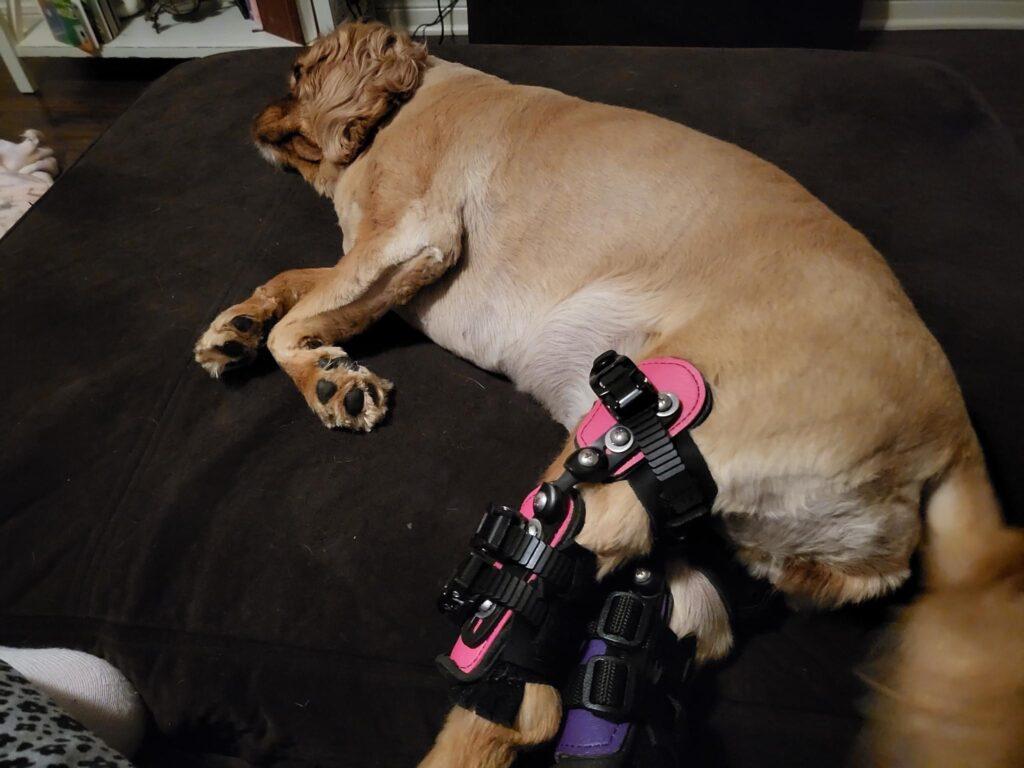
Your dog’s patella is its kneecap. The femoral trochlear groove, which is naturally present at the femur’s end, is where the patella ordinarily slides up and down in the middle of the knee. Unfortunately, the dog’s knee might develop genetic flaws that cause the kneecap to slide to one side or the other. A lateral luxation occurs when it slips to the outside. It is a medial luxation if it slides inward.
The majority of medial luxations affect tiny breeds like Boston Terriers, Chihuahuas, Miniature Poodles, and Pomeranians, Akitas, Great Pyrenees, Flat-Coated Retrievers, Chinese Shar Peis, and other large dogs frequently exhibit lateral luxations.
Only 7% of puppies have patellar issues, and the majority of them exhibit signs of luxation in both back legs.
You might notice your dog “skipping” occasionally when he moves, holding up a leg, or pausing and extending out his back limb before moving again if his kneecap is misaligned. Puppies with severe luxations may modify their stance, giving them a knock-kneed or bowlegged appearance (medial luxation) (lateral luxation).
Physical examinations are typically used to identify kneecap issues. Due to the possibility of an association between the two issues, your veterinarian will also examine your pet’s cranial cruciate. X-rays are frequently advised to check for further orthopedic issues that can affect treatment, like hip dysplasia.
Treatment is dependent on how severe the luxation is. Especially in smaller dogs, grade 1 and many grade 2 instances are frequently left alone while being kept an eye out for emerging issues. Grade 3 and grade 4 instances typically require surgery to keep the dog comfortable and lessen the likelihood of future orthopedic issues.
In order to keep the patella in place during dog knee surgery for a dislocation, the soft tissues on the side opposite the luxation are typically tightened. To assist in keeping the kneecap on its optimal course, the femoral groove may be deepened. To realign important muscles and give the leg a more typical anatomy, the tibial crest may be repositioned. Osteoarthritis is a common later-life ailment in dogs with kneecap issues.
Bracing can be used to stabilize the knee, with a LP, to give shock absorption, and to help prevent a CCL tear. Most dogs with a luxating patella will also get a concurrent Cruciate ligament tear, so it is important to do something to prevent this. Physical therapy is also something that is recommended, to help strengthen the surrounding muscles, and help with a grade 2 or less.
The majority of cruciate ligament issues are caused by trauma, however, they can also be degenerative. It can be an acute injury brought on by the dog turning too tightly while moving quickly, for instance, or it might be a low-grade, ongoing issue that has gotten worse over time (cruciate disease). Tears might be either partial or full, but this can’t be diagnosed without an MRI. Your veterinarian may tell you it is a Full tear, but without sound imaging, that is impossible to fully diagnose.
Your dog has two cruciate ligaments: the caudal, which is in charge of the joint’s forward stability, and the cranial (rear stability). These ligaments “cruciate” or cross over the knee joint between the top of the tibia and the bottom of the femur. They allow for extension and flexion while also giving the knee joint stability. Movement from side to side is restricted.
When dogs are active—running, making sudden turns, stepping in holes while running, and other such activities—they frequently damage their ligaments. However, something as easy as an obese Beagle leaping from the couch and landing awkwardly might tear a ligament. Environmental elements like lifestyle choices and weight are risk factors for cruciate issues, as well as spaying and neutering too soon (see our blog on spaying and neutering too early on the Posh website)
The ligament fibers are stretched and torn with sudden, intense pressure. The majority of dogs will become suddenly three-legged lame and hold up the injured leg. The joint could become painful, swollen, and inflamed. Less obvious symptoms of a chronic partial tear may resemble arthritis. After a period of inactivity, your dog can become particularly stiff and/or have intermittent lameness.
Large, muscular breeds of dogs, such as Labrador Retrievers, Golden Retrievers, German Shepherd Dogs, Rottweilers, and Pit Bulls, are most susceptible to cruciate ligament tears.
Due of the prevalence of this injury in laboratories, Research Laboratory offers a genetic test to check for cruciate issue susceptibility. Though not definite, a dog with a positive result on this genetic test is thought to be at a higher risk of cruciate rupture: roughly 62% genetics plus 38% environment. Owners should exercise frequent physical therapy and be more watchful to avoid their dogs from gaining weight.
The knee injury in your dog will probably be identified by your veterinarian after a physical examination. An obvious sign of a tear is a lax (loose) joint, or drawer test. Additional diagnostic procedures may include radiographs, to check for arthritic changes and/or arthroscopy, a surgical procedure that enables the veterinarian to examine the menisci, two cartilage discs that cushion the knee joint, in the joint.
Small dogs may benefit from wearing a brace that is specially made for them, as they tend to recover well with conservative management. Sometimes they may require extracapsular repair surgery, which involves placing a suture to stabilize the joint until scar tissue takes over. This procedure should never be done on dogs over 40lbs.
Some veterinarians may recommend very invasive surgery, that involves relocating and cutting bones in the joint. This is currently the only surgical option for large breed dogs, and should be researched with caution. The tibial plateau leveling osteotomy (TPLO) and the advancement of the tibial tuberosity are two of these treatments (TTA). (We recommend to try others means before doing surgery, but this is an option if you choose it.)
If you decide on conservative therapy combined with a Posh Dog Knee Brace, consider having our custom brace created, to give your dog the best chance of recovering. Regardless of size, a brace could be the best solution for dogs who are not suitable candidates for surgery, or if you prefer a conservative approach.
Regardless of the course of action you and your veterinarian determine is best for your dog, aftercare is crucial. Careful guidelines must be adhered to exactly as prescribed by your veterinarian. We include such a program with our custom Posh Brace.
A program of walks that gradually increase in distance and difficulty will be part of the rehabilitation, as will other workouts like an underwater treadmill. It might be suggested to use laser and pulsed electro-magnetic field (PEMF) therapy. It may be advised to use joint supplements to maintain his joints and delay the onset of arthritis. Unfortunately, 40–60% of dogs that rupture one cruciate will also eventually damage the other if nothing is done. This % will go up after surgery, by a significant amount, and decrease with custom bracing.
The likelihood of an injury and a full recovery might be influenced by your dog’s general health. Maintain your dog’s ideal weight. Look into an exercise plan to help him build his core muscles, as well as balances drills like wobble board or peanut work. Regarding your dog’s conformation is reasonable. To further reduce the chance of damage, you can think about conducting scent work or rally with your dog instead of agility or fly ball. If you dog already has 1 injured knee, or a knee that has had surgery, consider also bracing the good leg, in order to prevent overcompensation on the other side.
Check out our Facebook Page!
Hey guys, let’s talk about your dog limping front leg issues today, and reasons this may happen. This can be as simple as a sliver or foreign body in the paw to trauma. If you can’t find anything externally causing your dog to limp, it is important to seek a veterinarian, especially if the limping persists. Some common reasons are: strains or tears in ligement or tendon/muscle, something in paw, insect bite/sting, trauma/broken bones, vascular issues, lymes disease, inflammatory condition, osteoarthritis.
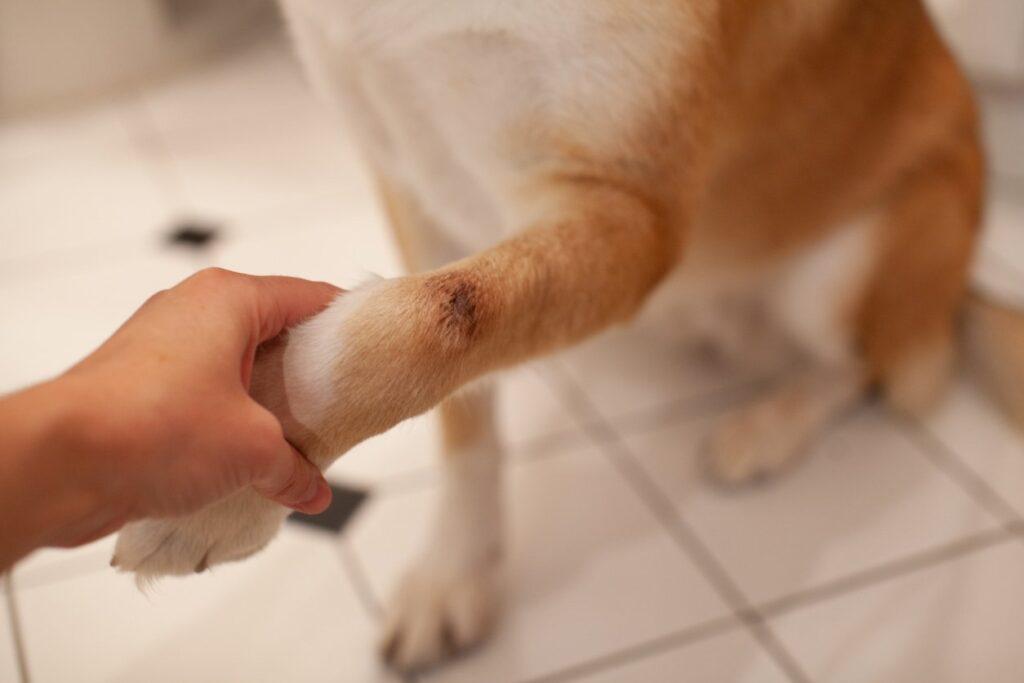
Now, depending on where the issue is happening may give us more information on what to do to help. For instance, your veterinarian will usually begin with the toes and work their way up to the neck/spine. Sometimes we need to give the veterinarian any information needed to be helpful. Such as, did you see your dog’s injury? Did this happen suddenly, acutely?
Was it something that is getting slowly worse day by day? Did your dog jump out of something like the car or back of a truck? Did your dog slip on ice or flooring, causing the front legs to go out to the side? Did your dog get it’s foot caught in something and try to yank it out? Have you had your dog on flea and tick prevention during the tick season? Have you seen any ticks on your dog?
All of these are really good questions to ask yourself and remember to tell your veterinarian, to help with diagnosing your dog. Things like a tick you found a week ago could mean your veterinarian needs to titer test your dog, to make sure he is ok and does not have lymes. Or if you didn’t think about the fact that your dog jumped down from the deck or bed, and now seems to be limping.
It could be that your dog is a large breed, and during growing developed OCD, Osteochondritis, in the shoulder, which will need surgery to fix. Or, perhaps you have an older dog who is showing pain, and could have arthritis showing up in the elbow or shoulder area. These are all good reasons to give your Veterinarian all the information you can, so that they can correctly diagnose.
We do have an elbow brace here at posh dog knee braces, that can help to stabilize any issues in the elbow joint, and relieve pain, if it is found to be an issue in the elbow. Let us know if you have any questions!
If you are interested in purchasing a Posh Dog Knee Brace for your dog limping front leg you can order your brace from our store, if you would like to join our Facebook community click here.
Hey guys, let’s talk about different braces for dogs that are out there. We will go over the cheaper, over the counter options, as well as custom braces, and casted braces, and which may be the better option for your and your furry best friend. First, before purchasing or looking for any type of brace for your dog, please make sure the injury is in the knee. There are other issues that can look just like knee injuries, however, it may be something else going on. So, always have your dog checked out by a Veterinarian or naturalpath before purchasing any orthotic for your dog.
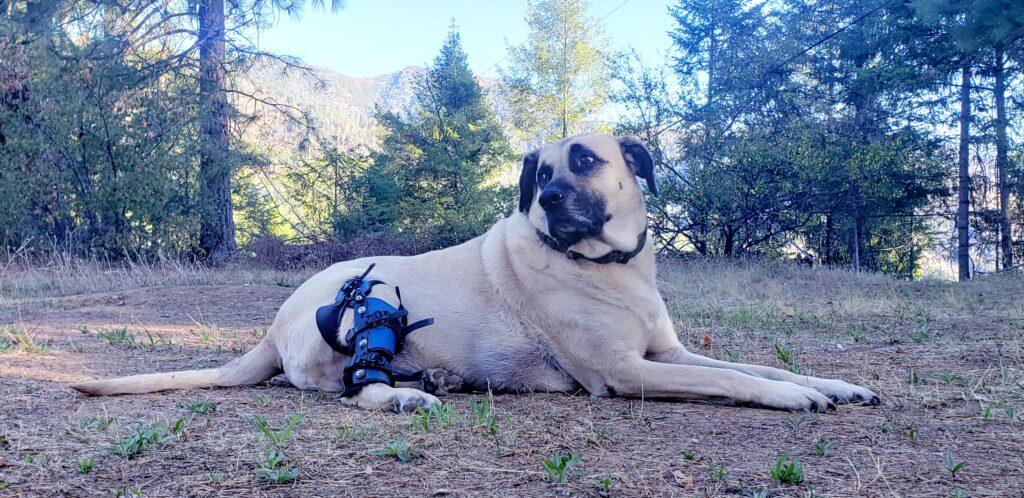
You know, the ones you can find on chewy or amazon, sometimes even online, that advertise amazing results for under $200. Sounds great, right? Well, truthfully these products are not meant for full stability. If your dog has a minor strain or sprain, and just needs to take things easy for a couple of weeks, a lot of people feel they need to get right in there and put a soft brace on their dog. This can actually cause the injury to worsen, cause rubbing sores, and really did not do anything to help your poor dog.
While they may be budget friendly, they really are not in the end. More than 80% of people that purchase these “non refundable” soft braces online end up getting a custom orthotic anyways. Sadly, some of these companies are charging up to $500 for these non-custom products, promising great results. Don’t fall for these, anything that needs a strap or stirrup to go up over the back or connect to a collar or harness is not a custom product, and will not work long term for your dog’s injury.
If your dog only has a small sprain, just let them recover by keeping them quiet and leashed for a few weeks, and they will be just fine, no need to spend your money on soft braces. Unlike with people, a dog knee is just too angled for these to fit properly without the need for straps, and they will not stay up.
You will see a few companies that try to say casted braces are the only way to go custom. Well, that is not necessarily correct. If you are in a local area for one of these places, and are able to go into their manufacturing facilities to have them actually do the cast, then you may be ok, however, in our experience, even veterinarians get casts wrong, and this can be a huge headache. Then, you will need to remake your appointment at the vet’s office, possibly re-sedate your poor dog, and remake the cast again. And if your dog has hair, this can be quite a painful process.
Then, if all of that is finally finished, you now have a hard plastic, not forgiving, brace. How would you like to have hard plastic up against your sensitive areas/groin? Or on the soft tissue of your ankle? And you can imagine that if your dog starts to get back into walks and gains muscle back, now there is a new issue. The brace was made for your dog’s leg circumference at the time of casting, but if your dog looses weight or gains muscle, the brace no longer will fit, and you are looking at a lot of modifications, or most likely the need to completely remake the brace. Not really cost effective anymore, is it?
You can tell that this brace was made with our dog’s comfort and daily activities in mind. There is no need for casting, we do everything through our proprietary computer software, that allows us to make a perfect fitting dog knee brace the first time. Also, our custom dog knee brace will last you for the rest of your dog’s life. It is waterproof, weather proof, easy to care for, comfortable, and actually made with decades of experienced hands.
Not only that, but we do a fitting video call with all of our clients, so you get to have one on one time with our certified veterinary technicians to help with physical therapy, walk schedules, and supplements. No other company offers this, for free, with the brace. I know, right? Posh is one of a kind, as there is no hard plastic touching your poor dog’s sensitive areas. Most people comment that they want us to make them a brace, as it is so well made! The semi-rigid shells provide support for the knee, without taking away the comfort.
So, there you have it! The 3 types of braces for dogs. Let us know if you have any questions!
If you are interested in our braces for dogs please check out out store page or visit our Facebook Page for more information.
Hey guys! I just wanted to make a note about brace “slipping” questions. It came to my attention that some people were concerned about if our brace slips down. Here are some things to consider if this happens. Also, on small note, when sending us pics, always include a bent knee picture. Sometimes what looks to be slipping on a straight leg picture, is actually a perfect knee center on a bent knee. Something to keep in mind, bent knee is key! #slippingquestion
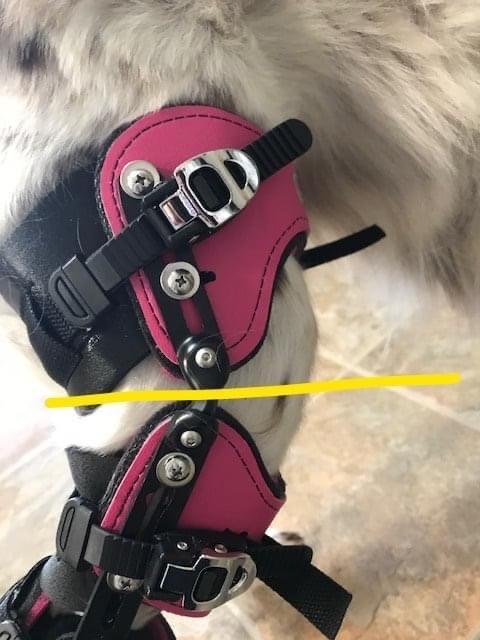
1. When I did the fitting call with Lady and her brace, we initially have the top edge of the middle shell right at the tibial tuberosity bump. It is completely normal for the brace to “adjust” down about 1 finger below this point. This is because the joint center of the brace is finding the correct pivot point of the knee. This is normal, and why we have you re-tighten the middle shell after 5-10 minutes into your walk.
2. If the lower shell and pad stay above the hock (which is where they should be) then the brace is not truly slipping down. We have designed our brace to stay on the ankle, and if it does slip down past the bend of the ankle, please let us know about it.
There are a few reasons this may happen, number one being that the tensions were not correct. number 2 is that the tibial shell may bee too short, number 3 being that the upper shell is too high in the groin (meaning that the belly or short femur may be causing the brace to slip down), number 4 is your dog sat/layed down on the brace, and possibly released the buckle levers, causing brace to loosen up. All these scenerios we can help you with if having an issue, so that they do not happen again.
3. Please email us in service if you have any fit questions, as only one of our technicians will be able to help if you need an adjustment made. Do not do any adjustments on your own, like moving shells, or there will be a charge to fix it (unless we have directed you to do so), and you may void your warranty. You are welcome to shorten straps, though, without us:)
4. Trust us, we have fit over 6500+ patients in braces, we know what we are talking about, and we want what is best for your pup.
5. As always, if you have any concerns regarding the brace fit, you have our service phone number and email, and we will always get back to you within 24 hours. If you have any questions before ordering a brace, send me a contact form, and I can answer any questions for you! Thanks!! Also visit our Facebook page for more helpful tips.
Read reviews check out our Google Reviews online. Click Here
Today I want to talk about hair length, and if it is necessary to shave your dog for our our brace. For the measurement call, we need to be able to see all the bumps in the knee. The hair needs to be less than 1” in length.
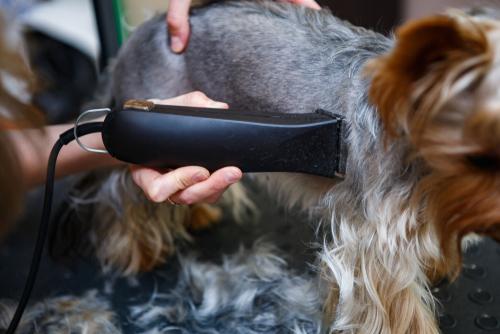
If you have a curly haired dog, you can try wetting down the hair in order to find the bumps. You will also need to make sure you can see those bumps and landmarks clearly for when you are fitting the brace.
If your dog has shorter hair on front of the leg, and feathering behind the thigh, you are probably ok. For dogs that have very long hair, like newfies or Great Pyraneese, they will need legs trimmed/shaved down to the ankle, otherwise we can’t see landmarks to help you measure. Let us know if you have any other questions, you can reach us at our contact page or visit our Facebook page.
Nikki, Posh Lead Veterinary Technician
Read reviews check out our Google Reviews online. Click Here
Custom-made braces can help your dog after knee surgery – and can sometimes be used in place of surgery.
Ten years have passed since WDJ explored “conservative management” – the nonsurgical treatment – of knee ligament injuries (see “Saying ‘No’ to Surgery,” February 2010). Since then, although surgery remains by far the most widely used knee injury treatment, consumer demand for complementary therapies, including the use of custom-designed knee braces, has grown.
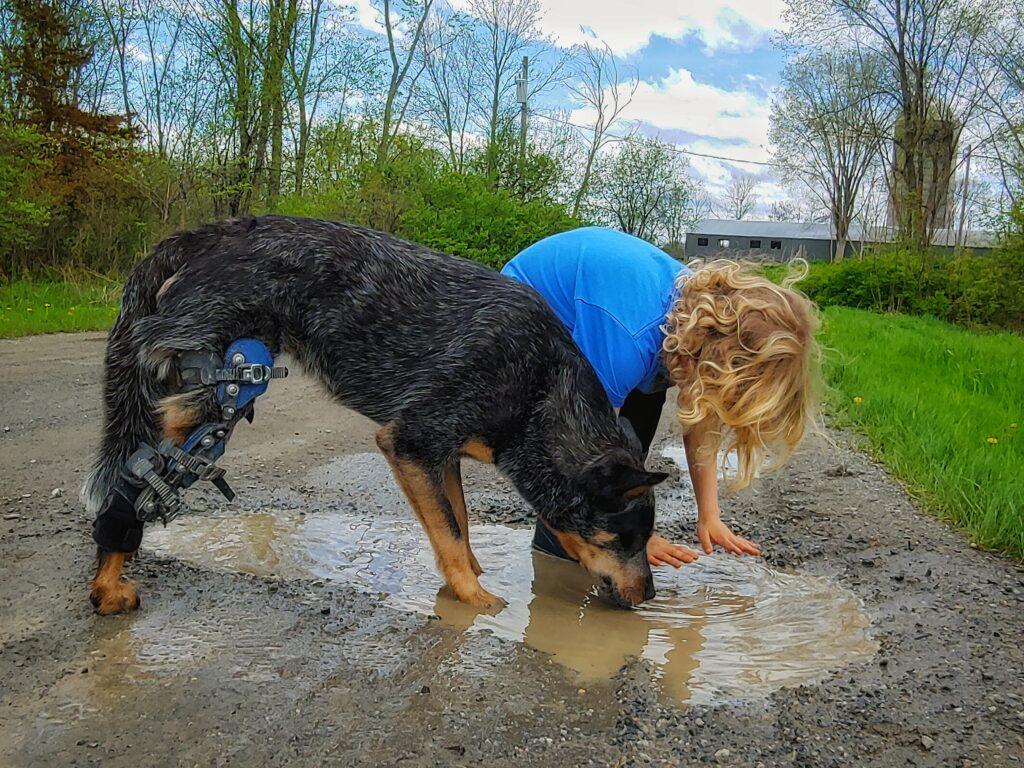
The majority of custom canine braces are made using materials supplied by the brace maker and are based on leg models that were cast in a veterinary office or at the client’s house. The resulting cast and supporting measures are provided so that the brace can be custom-made to suit. Sometimes casting needs to be redone because the cast was improperly created or was damaged during shipping. The appointment raises the price of the brace if done in a veterinary hospital.
The 11-year-old, 77-pound Golden Retriever named Pasha, who inspired the creation of the Posh Dog Knee Brace, had a left hind limb injury. When Pasha’s veterinarian discovered a ruptured cranial cruciate ligament and torn meniscus, he advised emergency surgery, stating that delaying treatment would result in a similar injury to Pasha’s right leg, severe arthritis, and a lifetime of inactivity for the dog.
Although Florida residents Jim Morison and Beth Scanlon, Pasha’s owners, could afford the $5,000 procedure, they were concerned due to Pasha’s age and past health issues, which included a history of anesthesia-related complications. Pasha’s rehabilitation started when they decided against scheduling surgery and purchased a personalized canine knee brace.
Read full article visit: https://www.whole-dog-journal.com/health/canine-knee-injury-brace-yourself/
To purchase a Posh Dog Knee Brace – Click Here
Read reviews check out our Google Reviews online. Click Here
In February, we got a lot of snow and cold weather. Which is a perfect scenario to see how well the brace performs under such conditions. The Posh Dog Knee Brace is not a cast. So there are many open spaces. And that made me wonder how well the brace would perform in a Canadian winter with deep snow and cold temperatures.
Please visit: https://www.myboxergirl.com/health/posh-dog-knee-brace-winter-performance-review/
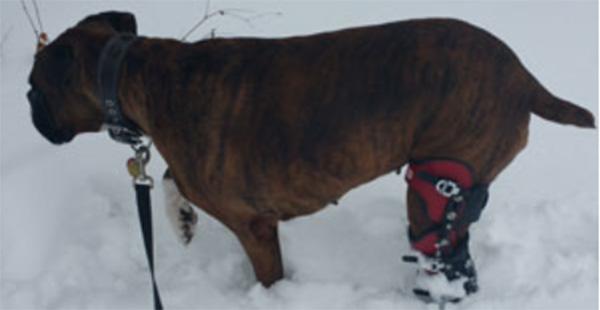
The brace has surprise delivered excellent results during the winter. And over the past five months, Annie’s quality of life has significantly improved thanks to the Posh Dog Knee Brace. Annie used to go on very brief walks—10 to 15 minutes—before we got a brace. Additionally, Annie was limping after those walks. Since we started using the brace, Annie has been out walking for a lot longer, which has given her enough exercise to feel somewhat pleased. With an active Boxer, this task is not simple.
To purchase our brace check out our store.
Read reviews check out our Google Reviews online. Click Here
Today let’s talk about how to train your dog to use or walk with the brace. First, I want you to use just the hock wrap, to let your pup get used to having something on his ankle. Do this for 30 minutes on and off the first couple of days.
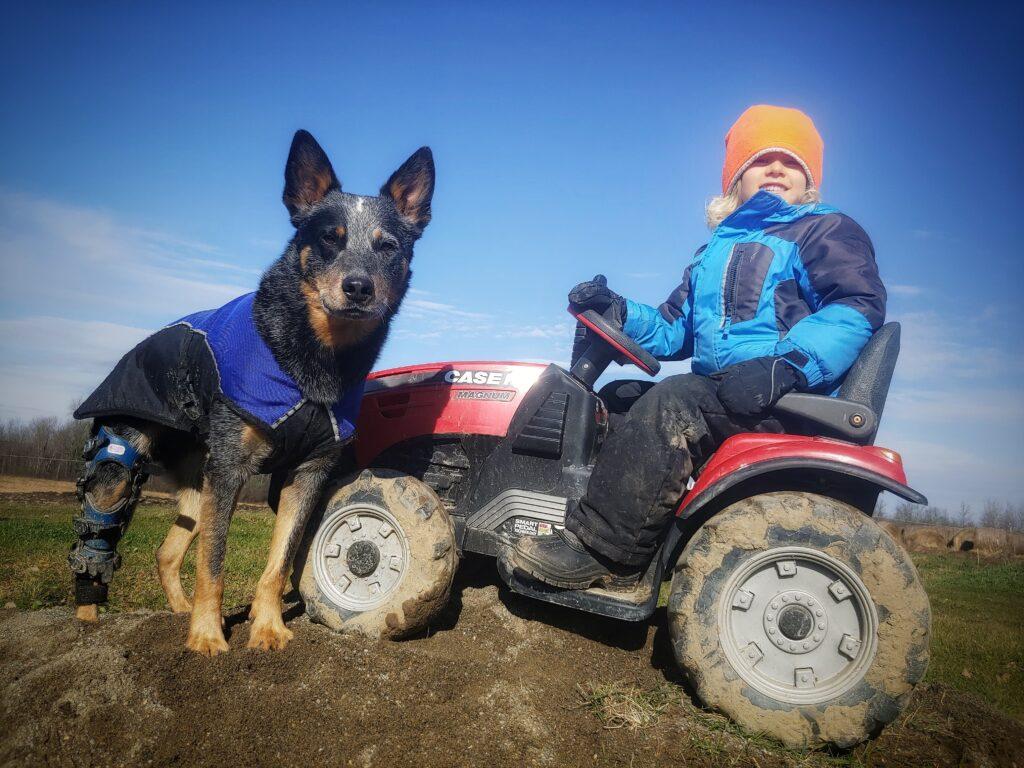
Next, I like to freeze peanut butter in a dish, and distract my dog while fitting the brace on, this will help train your dog to get used to you putting the brace on him.
Once you have a brace on, go directly outside and walk. Then, remove the brace when you come in. Distraction and treats work great while getting your dog used to wearing the brace.
Soon, your dog will link the brace to getting to go out for a W-A-L-K, something really fun.
Then, you can increase the wearing times as stated on our physical therapy handouts. Let me know if you have any questions you can contact us through our contact form or reach out to us on our Facebook Page.
Nikki, Posh Lead Veterinary Technician
Read reviews check out our Google Reviews online. Click Here
This is a must read article about the prevention, causes and REAL treatments for Cancer. We want you to be able to cherish 16 ++ years with your beloved Dog, not 7 or 9 years.
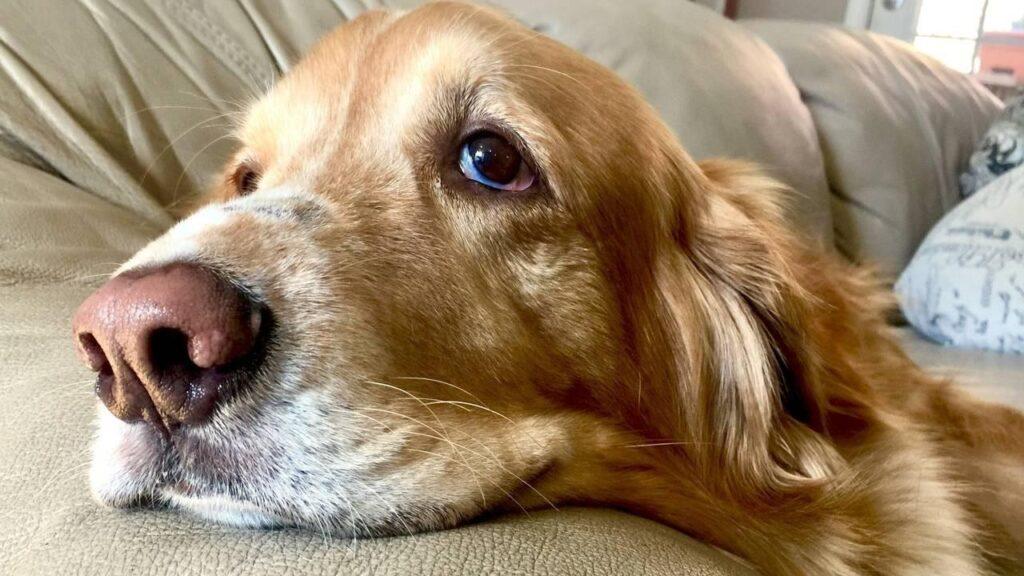
Although our core focus at www.PoshDogKneeBrace.com is helping Dogs with a brace for Dogs for a torn ACL in Dogs, most Dog cancers can be prevented if Dog parents knew the truth about cancer. So many Dogs are being fed foods that cause cancer and taking carcinogenic chemicals like flea and tick programs and “vaccines,” that we want to share some of what we have learned, above and beyond a Dog brace or a knee brace for Dog.
Read reviews check out our Google Reviews online. Click Here
5 years this weekend will be our Anniversary, our Beloved Golden Angel Pasha had a complete rupture of her left hind leg and severely damaged meniscus. Our former vet demanded that 11 year old Pasha get TPLO surgery. She said “dog knee braces are junk.” Then she admitted she had never seen one. Beth discovered Dog knee braces. Jim would have rushed into TPLO surgery, because “the vet said so.” Until Jim went to TiggerPoz.com and read the facts about the CCL racket. Now TiggerPoz recommends the Posh Brace.

After ordering several inferior, but expensive braces, we saw that they did work, quite well. Pasha was able to bear weight on her leg immediately. But we wanted a brace that was better: rust proof parts, ladder straps and micro – buckles (not a lot of cheap velcro), and a more effective design. The other brace companies refused to modify the braces we had purchased (even after we offered another $400 to change each of them).
All the custom dog knee brace companies seemed to lack empathy for Pasha. We suspect they have never been through seeing an 11 year old Dog, who was our child, limping in pain. Their customer service was seriously deficient. So we set out to correct these problems. A torn ACL in Dogs is very stressful for the Dog parents also.
We assembled a small team of experts, and in August 2013, Pasha wore the first Posh Brace. We named our new company after one of her nicknames: “Posh.” After nearly 5 months of prototyping, we started helping other Dogs.
Our first customer for our Dog knee brace was a 14 year old beautiful boy named Cody. He had cancer and was undertaking the hideous chemo (poison). Despite being the poorest candidate for CCL surgery, his vet went ahead and operated on Cody. The surgery failed. Cody had a 4 inch long inflamed, oozing incision on his knee, and could barely stand. We made a posh brace Cody on 12/17/13. It had to be built so as not to impinge on his painful incision. On 12/23/13, codys’ father, Brett, sent us this email:
“Jim
Just got back from a 45 min walk for first time in three months! He had a blast and was smiling and marking every mailbox post ( even stood on his braced leg ) like it was nothing! Brace was great and will talk with you later this week!
Merry christmas
Brett & Pam…Cody too!”
That set us on fire! For 2 reasons: 1. that we helped this old, infirm beautiful Dog and he could walk again with his Mom and Dad. 2. The sheer amoral avarice shown by some “vets” had to be disrupted.
Since then, we have continually added better designs. This is our 4th edition of the Posh Brace. 3 Anniversary, we eliminated the archaic casting requirement nightmare (using proprietary software to make a mold of your Dogs’ leg from measurements, pics and other data), and, the “concrete,” inflexible shells and created a flexible Posh Brace. As Beth, our Co-Founder says: “who has hard plastic shoes??” In 2016 we hired our first phenomenal Vet Tech, Nikki. In 2017 – 2018 we hired other great Vet Techs, including Jami.
Because of our thousands of loyal customers, now we help more Dogs recover from CCL injuries, with NO surgery, around the world, than any other custom Dog knee brace company. Thank you for letting us help your beautiful Dog!
If you are interested in purchasing a Posh Dog Knee Brace or have questions please visit our Store or send us a email through our contact form. You can also visit our Facebook Group for more information.
Read reviews check out our Google Reviews online. Click Here
Here’s a story about one of our customers, a beautiful 9 year old rescue named Rummy, who had his Posh Brace stolen from him. Well, when we say we are obsessed with helping Dogs, we mean it. So a thief would not get away with inhibiting Rummys’ recovering, we sent out a free $895 custom replacement in 3 days, after the thief got away with Rummys’ 1st custom Posh.
If you like what we do to help Dogs every day, please SHARE this story with everyone and LIKE our FACEBOOK page, and tell all your pals with Dogs, that our custom Posh Brace helps Dogs avoid an expensive and risky knee ligament CCL/ACL surgery! Sure we lost money on this, BUT we are helping Rummy recover like our baby Pasha did 3 years ago. So we figure – we won.
Please help us to spread the word: most vets won’t do anything but make lots of $$$$ from surgery.
http://www.chicoer.com/…/doggone-thief-snatches-injured-can…
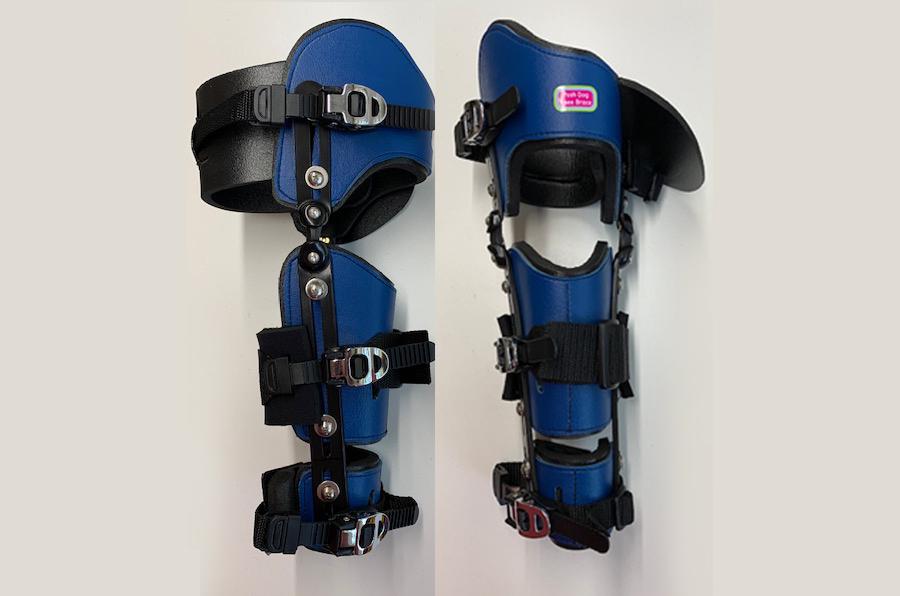
Interested in Ordering a Brace? Click Here
Read reviews check out our Google Reviews online. Click Here
You may need a support sling with helping a Dog with a dog knee injury up and down stairs etc. We make a great Dog knee brace. We did find this great idea for making a sling for your Dog – for about $3.00 and in 5 minutes:
Click Here to Read Full Article
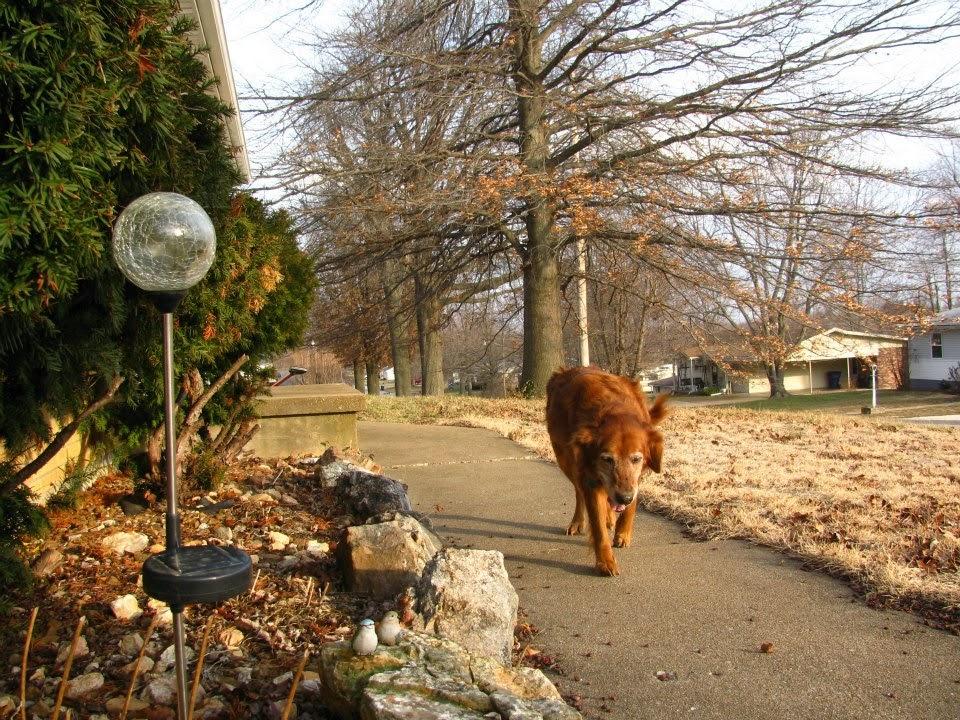
Interested in Ordering a Brace Click Here or need more information you can fill out our contact form.
Read reviews check out our Google Reviews online. Click Here